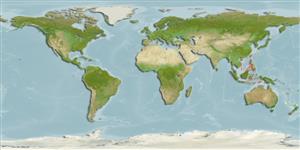>
Gadiformes (Cods) >
Macrouridae (Grenadiers or rattails)
Etymology: Kuronezumia: Japanese, kuronezumia = black mouse or rat. Personnal communication of Tomio I. Curator in the Calif. Academy of Sciences, Ichthyology.
More on authors: Smith & Radcliffe.
Environment: milieu / climate zone / Tiefenbereich / distribution range
Ökologie
seewasser bathydemersal; tiefenbereich 622 - 803 m (Ref. 9950). Deep-water
Western Central Pacific: known only from the Philippines.
Size / Gewicht / Alter
Geschlechtsreife: Lm ? range ? - ? cm
Life cycle and mating behavior
Geschlechtsreife | Fortpflanzung | Ablaichen | Eier | Fecundity | Larven
Shcherbachev, Y.N., Y.I. Sazonov and T. Iwamoto, 1992. Synopsis of the grenadier genus Kuronezumia (Pisces: Gadiformes: Macrouridae), with description of a new species. Proc. Calif. Acad. Sci. 48(3):97-108. (Ref. 9950)
IUCN Rote Liste Status (Ref. 130435: Version 2025-1)
Bedrohung für Menschen
Harmless
Nutzung durch Menschen
Tools
Zusatzinformationen
Download XML
Internet Quellen
Estimates based on models
Preferred temperature (Ref.
123201): 5.6 - 8.2, mean 6.5 °C (based on 56 cells).
Phylogenetic diversity index (Ref.
82804): PD
50 = 0.5078 [Uniqueness, from 0.5 = low to 2.0 = high].
Bayesian length-weight: a=0.00575 (0.00194 - 0.01707), b=3.08 (2.83 - 3.33), in cm total length, based on LWR estimates for this (Sub)family-body shape (Ref.
93245).
Trophic level (Ref.
69278): 3.6 ±0.5 se; based on size and trophs of closest relatives
Widerstandsfähigkeit (Ref.
120179): niedrig, Verdopplung der Population dauert 4,5 - 14 Jahre. (Preliminary K or Fecundity.).
Fishing Vulnerability (Ref.
59153): Low to moderate vulnerability (33 of 100).
🛈
